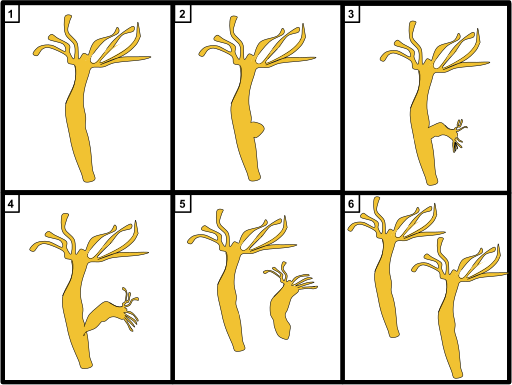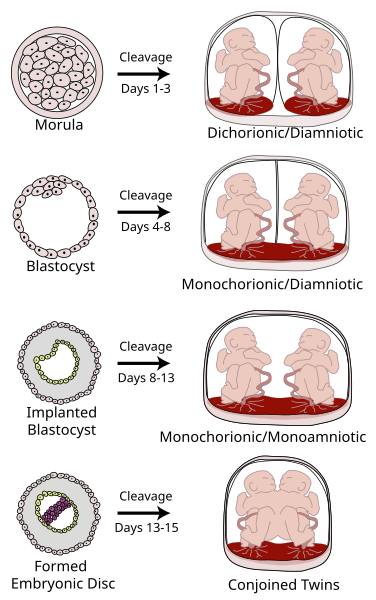OCR Specification focus:
‘Give examples of natural animal clones, such as identical twins formed by embryo splitting.’
Natural animal cloning occurs when genetically identical individuals are produced without human intervention. It results from asexual reproductive mechanisms or embryonic processes leading to identical offspring sharing the same DNA.
Natural Animal Cloning Overview
Natural cloning in animals is the spontaneous production of genetically identical organisms from a single parent organism. This can occur through asexual reproduction or embryo splitting during early development. Unlike artificial cloning, these processes happen naturally and contribute to species survival, population stability, and the propagation of advantageous genes.
Key Concept: Genetic Identity
Natural clones share identical nuclear DNA, meaning they originate from the same zygote or parental genetic material. However, mitochondrial DNA (mtDNA) can vary if the process involves separate oocytes, slightly influencing metabolic characteristics.
Asexual Reproduction in Animals
Asexual reproduction is rare in the animal kingdom compared to plants and microorganisms, but several species exhibit it naturally. In these cases, offspring are clones of the parent.
Examples of Asexual Reproduction in Animals
Hydra reproduce by budding, producing miniature versions of themselves that detach and grow independently.

Sequential, labelled budding diagram in Hydra, showing bud formation, growth, cleavage at the base, and detachment of a genetically identical offspring. This visual reinforces that cloning in animals can occur asexually without gamete fusion. The panel numbers (1–6) correspond to each morphological step described in the notes. Source.
Starfish and sea anemones can reproduce by fragmentation, regenerating complete individuals from body parts.
Aphids demonstrate parthenogenesis, where unfertilised eggs develop into new individuals identical to the mother.
Komodo dragons and some reptiles have been observed undergoing parthenogenetic reproduction under isolated conditions, ensuring survival when mates are unavailable.
Cellular Basis of Asexual Cloning
In these processes, mitosis produces genetically identical cells. There is no meiosis or gamete fusion, so genetic variation is absent, ensuring all clones are genetically uniform.
Mitosis: The process of nuclear division resulting in two genetically identical daughter cells from one parent cell.
This method allows rapid population increase but reduces genetic diversity, which may decrease adaptability to environmental changes or disease.
Embryo Splitting: Identical Twins and Other Embryonic Clones
Natural embryo splitting is the primary mechanism of natural animal cloning in mammals, including humans. It occurs when an early zygote divides into two or more separate groups of cells, each capable of developing into an independent organism.
Mechanism of Embryo Splitting
Following fertilisation, a zygote undergoes cleavage divisions, forming a ball of cells called a morula.
Occasionally, cells within the morula separate into distinct groups.
Each cell mass continues to divide and form a blastocyst, implanting independently in the uterus.
The resulting offspring—monozygotic twins—are genetically identical and share the same DNA sequence.

Labeled schematic of twin placentation showing dichorionic–diamniotic, monochorionic–diamniotic, and monochorionic–monoamniotic outcomes from different embryo-splitting times. This clarifies how a single zygote can form two embryos and how membranes and placentae vary accordingly. The diagram includes chorionicity/amniosity terminology, which slightly exceeds the syllabus wording but helps interpret natural twin formation. Source.
Identical (Monozygotic) Twins
Identical twins arise from a single fertilised egg (zygote) that splits early in development. They share identical genotypes and are therefore natural clones.
Zygote: The single cell formed when two gametes (sperm and egg) fuse during fertilisation.
This process differs from dizygotic (fraternal) twins, which develop from two separate eggs and sperm, resulting in genetically distinct siblings.
Examples of Natural Cloning Across Animal Groups
Invertebrates
Hydra: Reproduce via budding, producing genetically identical offspring attached to the parent before detaching.
Starfish: Can regenerate lost arms or entire organisms from a single arm segment.
Corals: Form large colonies through budding and fragmentation, generating extensive identical populations across reefs.
Vertebrates
Amphibians and fish: Some species produce identical offspring via parthenogenesis, allowing rapid population recovery.
Mammals (including humans): Produce identical twins through embryo splitting, the most recognised form of natural cloning.
Human Identical Twins
Human identical twins exemplify natural cloning. They have identical DNA, blood groups, and genetic traits, though environmental factors can produce differences in epigenetic expression or phenotypic traits such as fingerprint patterns or height variations.
Importance of Natural Cloning in Evolutionary and Ecological Contexts
Natural cloning plays a significant role in species continuity, population growth, and genetic stability.
Advantages
Rapid reproduction without the need for mating.
Preservation of successful genotypes, particularly in stable environments.
Guaranteed offspring production when mates are scarce.
Regeneration and repair in multicellular organisms (e.g., starfish regrowing limbs).
Disadvantages
Lack of genetic variation reduces adaptability to changing environments.
Increased susceptibility to disease and genetic disorders.
Population vulnerability if a single clone is affected by a mutation or pathogen.
These trade-offs demonstrate why most animal species rely on sexual reproduction for long-term survival, reserving natural cloning for specific ecological or emergency conditions.
Cellular and Genetic Mechanisms Underpinning Natural Cloning
Natural cloning depends on mitotic division to ensure identical DNA replication. During asexual reproduction or embryo splitting, each daughter cell receives a full set of chromosomes identical to the parent.
DNA Replication Fidelity
DNA polymerases ensure accurate replication; however, occasional mutations may occur, introducing minimal genetic variation even among clones.
Epigenetic Differences
Although nuclear DNA is identical, environmental influences such as nutrition, hormonal exposure, and intrauterine conditions can modify gene expression through epigenetic changes (e.g., DNA methylation). These differences explain minor physical or behavioural divergences between clones like identical twins.
Epigenetics: The study of heritable changes in gene expression that occur without alteration of the DNA sequence.
Such epigenetic effects highlight that while clones are genetically identical, their phenotypes may still vary depending on developmental and environmental influences.
Summary of Natural Cloning Mechanisms
Natural animal cloning occurs through:
Asexual reproduction (budding, fragmentation, parthenogenesis).
Embryo splitting (formation of identical twins).
Regeneration (production of new organisms from body parts).
These mechanisms demonstrate nature’s capacity to produce genetically identical individuals for survival, repair, and reproduction—without human manipulation—illustrating a key biological phenomenon underpinning both ecology and biotechnology research.
FAQ
Identical (monozygotic) twins form when an early embryo splits completely into two separate cell groups, each developing into an individual.
Conjoined twins result when the embryo only partially splits or when the separated embryos fuse back together. The twins remain physically connected, often sharing organs or tissues, depending on where the incomplete division occurs.
The timing of the embryonic split is key — the later the division, the higher the chance of conjoining.
Yes. Natural cloning through embryo splitting has been documented in several mammalian species, including cattle, sheep, and armadillos.
In nine-banded armadillos, a single fertilised egg routinely splits into four embryos, producing genetically identical quadruplets.
In cattle and sheep, identical twins occasionally occur naturally, though the frequency is low compared to humans.
This demonstrates that natural cloning is not unique to humans but a rare, naturally occurring reproductive event among mammals.
Although identical twins have the same DNA, their gene expression can differ due to epigenetic modifications influenced by environmental factors.
Examples include:
Differences in nutrition and blood flow within the uterus.
Random mutations during embryonic cell division.
Exposure to different environmental conditions after birth.
These variations cause subtle differences in physical traits, personality, or disease susceptibility, even between genetically identical individuals.
Natural cloning allows rapid population growth and preservation of advantageous traits in stable, unchanging environments.
Benefits include:
No need for mates, saving energy and time.
Rapid reproduction when conditions are favourable.
Maintenance of successful genotypes that suit the environment.
However, in variable or hostile environments, this strategy is less advantageous, as lack of genetic diversity can limit adaptability and increase extinction risk.
Researchers use identical twins and naturally cloned animals as models to investigate genetic control, disease inheritance, and epigenetic variation.
Twin studies help separate genetic effects from environmental ones, advancing understanding of gene–environment interactions.
Observations of natural cloning inform techniques like artificial embryo twinning and somatic cell nuclear transfer used in animal cloning.
These insights also guide research into regenerative medicine and the development of stem-cell therapies.
Thus, studying natural clones provides valuable biological and biotechnological insights beyond reproduction alone.
Practice Questions
Question 1 (2 marks)
Explain how identical twins are formed naturally in humans.
Mark scheme:
(1 mark) Award for stating that identical twins result from the splitting of a single fertilised egg (zygote) in early development.
(1 mark) Award for stating that each split cell mass develops into a genetically identical embryo (monozygotic twins).
(Maximum 2 marks)
Question 2 (5 marks)
Natural cloning can occur in animals through asexual reproduction or embryo splitting. Compare and contrast these two processes and discuss one advantage and one disadvantage of natural cloning for a species.
Mark scheme:
(1 mark) Asexual reproduction involves one parent; embryo splitting follows fertilisation of an egg.
(1 mark) Asexual reproduction produces clones via mitosis; embryo splitting involves separation of cells from a zygote.
(1 mark) Both processes result in genetically identical offspring.
(1 mark) Advantage stated and explained, e.g. rapid population increase or preservation of successful genotypes.
(1 mark) Disadvantage stated and explained, e.g. reduced genetic variation or increased vulnerability to disease.
(Maximum 5 marks)

